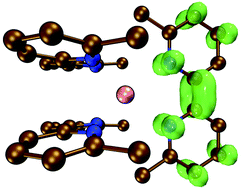Homoleptic tris(6,6′-dimethyl-2,2′-bipyridine) rare earth metal complexes†
Abstract
Homoleptic tris(6,6′-dimethyl-2,2′-bipyridine) rare earth metal complexes M(κ2-dmbp)3 (M = Y, Tb, Dy, Ho, Er; dmbp = 6,6′-dimethyl-2,2′-bipyridine) were synthesized by in situ reduction of 3 equiv. of dmbp with excess KC8 in the presence of 1 equiv. of rare earth metal trihalides. All compounds were characterized by X-ray crystallography, UV-Vis-NIR spectroscopy, infrared (IR) spectroscopy, elemental analysis, and magnetic measurements. While the structural parameters and spectroscopic data confirmed the existence of the trivalent rare earth metal cation and three dmbp radical anions, the electron paramagnetic resonance (EPR) spectrum and the measured magnetic moment of Y(κ2-dmbp)3 indicated that two parallel dmbp radical anions were antiferromagnetically coupled. For paramagnetic rare earth metal ions, room temperature magnetic susceptibility values indicated a weak ferromagnetic interaction between the metal ion and the remaining dmbp radical. Density functional theory (DFT) calculations were performed on Y(κ2-dmbp)3 to gain insight into the electronic structures of these homoleptic metal complexes. The computational results were consistent with the structural, spectroscopic, and magnetic data for a S = 1/2 ground state and spin densities mostly residing on one dmbp radical anion, while the spins on the other two parallel dmbp radical anions being antiferromagnetically coupled.

- This article is part of the themed collection: Rare Earth Chemistry – In memory of Professor Xu Guangxian at his centenary


 Please wait while we load your content...
Please wait while we load your content...